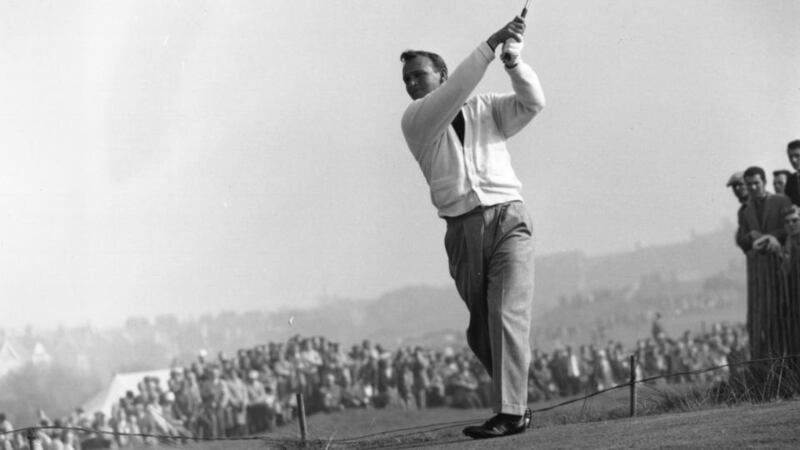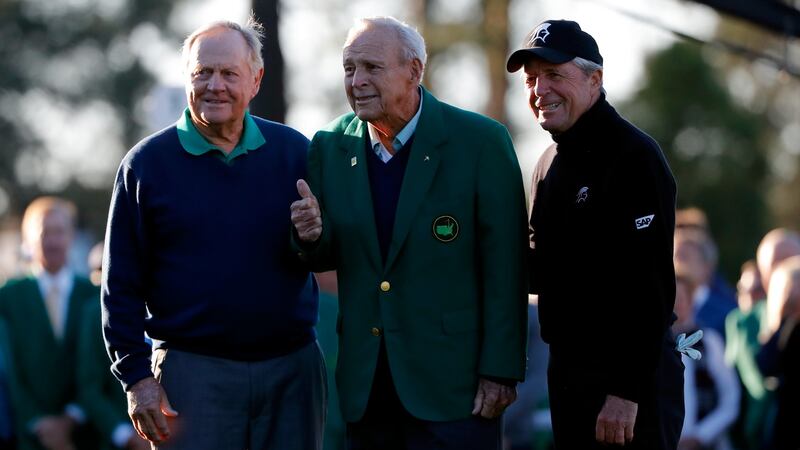Arnold Palmer, the champion golfer whose full-bore style of play, dramatic tournament victories and magnetic personality inspired an American golf boom, attracted a following known as Arnie’s Army and made him one of the most popular athletes in the world, has died. He was 87.
Alastair Johnson, chief executive of Arnold Palmer Enterprises, said Palmer, known as “The King”, died in Pittsburgh, Pennsylvania, of complications from heart problems.
“Thanks Arnold for your friendship, counsel and a lot of laughs,” Tiger Woods tweeted late on Sunday.


Remembering the special times I spent with Mr Palmer at Bay Hill. A true pioneer for our sport. Forever remembered. pic.twitter.com/qJQBpDWTWv
— Rory McIlroy (@McIlroyRory) September 26, 2016
We are deeply saddened by the death of Arnold Palmer, golf's greatest ambassador, at age 87. pic.twitter.com/iQmGtseNN1
— USGA (@USGA) September 26, 2016
“Your philanthropy and humility are part of your legend. It’s hard to imagine golf without you or anyone more important to the game than the King.”
From 1958 through 1964, Palmer was the charismatic face of professional golf and one of its dominant players. In those seven seasons, he won seven Major titles: four Masters, one US Open and two British Opens. With 62 victories on the PGA Tour, he ranks fifth, behind Sam Snead, Tiger Woods, Jack Nicklaus and Ben Hogan. He won 93 tournaments worldwide, including the 1954 US Amateur.
But it was more than his scoring and shotmaking that captivated the sports world. It was how he played. He did not so much navigate a course as attack it. If his swing was not classic, it was ferocious: He seemed to throw all 185 pounds of his muscular 5-foot-10 body at the ball. If he did not win, he at least lost with flair.
Handsome and charming, his sandy hair falling across his forehead, his shirttail flapping, a cigarette sometimes dangling from his lips, Palmer would stride down a fairway acknowledging his "army" of fans with a sunny smile and a raised club, "like Sir Lancelot amid the multitude in Camelot," Ira Berkow wrote in The New York Times.
And the television cameras followed along. As Woods would do more than 30 years later, Palmer, a son of a golf pro at Latrobe Country Club in the Pennsylvania steel town, almost single-handedly stimulated TV coverage of golf, widening the game’s popularity among a postwar generation of World War II veterans enjoying economic boom times and a sprawling green suburbia.
His celebrated rivalry with Nicklaus and another champion, the South African Gary Player – they became known as the Big Three – only added to Palmer’s appeal, and more often than not, he, not the others, had the galleries on his side.
“Arnold popularised the game,” Nicklaus said. “He gave it a shot in the arm when the game needed it.”
Hitching up his pants as he marched down the fairways or before lining up a crucial putt, Palmer put the word “charge” into golf’s vocabulary in 1960. In the final round of that year’s Masters, he birdied the 17th and 18th holes to win by one stroke. Two months later, in the US Open at Cherry Hills, near Denver, he shot a final-round 65 to win by two over Nicklaus.
“I seem to play my best in a big tournament,” Palmer said. “For one thing, my game is better adapted to the tougher courses. For another, I can get myself more keyed up when an important title is at stake. I like competition – the more rugged, the better.”
And if he lost, his army did not desert him. In the 1961 Los Angeles Open at Rancho Park, he recorded a 12 on the par-5 ninth hole when he hit four balls out of bounds. Palmer’s fans were deflated, like him, but somehow his flubs enhanced his appeal. He was human; he could blow a lead or a shot like any duffer. And they liked that he went down swinging, with his lunging, go-for-broke play. If he hit a wayward tee shot to an awkward spot, he usually went for the green, rather than chip the ball safely back to the fairway as other golfers would have done.
“You can make mistakes when you’re being conservative, so why not go for the hole?” he said. “I always feel like I’m going to win. So I don’t feel I’m gambling on a lot of shots that make other people feel I am.”
His nickname among tour pros was the King, although he never basked in the title. But it fit. He was the first athlete to receive three of the United States’ civilian honours: the Presidential Medal of Freedom, the Congressional Gold Medal and the National Sports Award. And he became a one-man multimillion-dollar conglomerate.
As the president of Arnold Palmer Enterprises, he supervised the design, construction and development of more than 300 new or remodelled golf courses worldwide, as well as golf clubs and clothing. The Palmer Course at The K Club in Kildare hosted the 2006 Ryder Cup.
After buying his first plane, a used twin-prop Aero Commander, for $27,000 in 1962, he became the first golf pro to pilot his own plane from tournament to tournament. He graduated to jets in 1966. The Latrobe airport is named for him.
With two co-pilots and an observer, he circumnavigated the globe in 1976 in 57 hours 25 minutes 42 seconds, a world record for jets in the 17,600-to-26,400-pound category. He spent more than 20,000 hours in the cockpit.
“Flying has been one of the great things in my life,” he said. “It’s taken me to the far corners of the world. I met thousands of people I otherwise wouldn’t have met. And I even got to play a little golf along the way.”
He was a part owner of the Pebble Beach Resort in California and principal owner of the Bay Hill Club and Lodge in Orlando, the site of the annual Arnold Palmer Invitational tournament on the PGA Tour. True to his roots, he made his primary home in Latrobe, but he spent winters at Bay Hill.
His handshake agreement with Mark McCormack, a Cleveland lawyer he met during a three-year stint in the Coast Guard, led to McCormack’s forming the International Management Group, now the world’s foremost sports agency. Palmer was its premier client.
One of Palmer’s disappointments was that he never won the US PGA Championship to complete a career Grand Slam. That failure especially hurt because his father, the Latrobe Country Club pro, was a PGA. member who had taught him the game.
“I should have won it a couple times,” Palmer said. “I wanted it too bad. Everyone was calling it to my attention.”
Palmer competed in the top ranks of a demanding, exacting game against some of history’s greatest players, so heartbreakers were probably inevitable.
At the 1961 Masters, Palmer needed only a par on the 18th hole to become the first golfer to win at Augusta National in consecutive years. But after a good drive, he skidded his 7-iron approach into a bunker, blasted out over the green, chipped 15 feet past the cup and two-putted for a double-bogey six to lose by a stroke to Player.
Palmer also lost three 18-hole US Open playoffs – in 1962 to Nicklaus at Oakmont, near Pittsburgh (it was Nicklaus’s first Major victory); in 1963 to Julius Boros at the Country Club in Brookline; and, in a particularly crushing defeat, in 1966 to Billy Casper at the Olympic Club in San Francisco, after he had led Casper by a seemingly insurmountable seven strokes with nine holes to go in the final round.
Palmer was nonetheless the PGA Tour’s leading money winner in 1958, 1960, 1962 and 1963 and its player of the year in 1960 and 1962. In 1968, he became the first golfer to earn more than $1 million in career prize money on the PGA Tour. The award for the leading money winner each year is now named for him.
Palmer was 77 when he played his final competitive round, on October 30th, 2006, at the Administaff Small Business Classic in Texas, on the Champions Tour. After hitting two balls into the water on the fourth hole, he withdrew with a sore lower back, although he finished his round – without keeping score – because he owed it to his fans, he said.
“The people, they all want to see a good shot,” he said, “and you know it, and you can’t give them that good shot. That’s when it’s time.”
(New York Times service)












